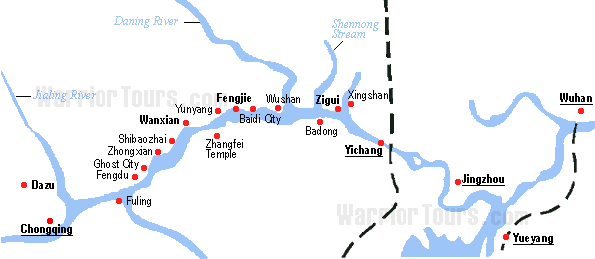Three Gorges


A cruise along the Three Gorges of the Yangtze offers a wonderful spectacle. Meandering 193 km (120 miles) between Hubei Province and Chongqing City, it flows through Qutang, Wu, and Xiling Gorges. For a thousand years, its beauty has attracted numerous artists and writers who left notable verses and relics for later generations. Today, reputed as a 'gallery of landscapes', it is among the most famous scenic spots of China as well as the world.
The magnificent first gorge is the Qutang Gorge extending eight kilometers (5 miles) from Baidi (White Emperor) City to Wushan County. Whirling waters run vigorously between sheer walls, forming the most distinctive highlight of the three gorges. The narrowest river passage is only dozens of meters wide, but most of the mountains on both sides tower over 1,000 meters (3,281 feet). En route are many scenic features, including the Ancient Plank Road, Bellows Gorge, Meng Liang Stairway, Rhinoceros Looking at the Moon, Daxi Culture, Chalk Wall, and Iron Lock Pass.
 Passing through the Qutang Gorge, visitors enter the second one, Wu Gorge. It is 45 km (28 miles) long and distinctive for its wandering deep valley, as well as for its serene dainty landscape - three terraces, eight scenes, and twelve peaks. Sometimes passengers may doubt there is an opening ahead because of the seeming enclosure of mountains; however, beyond the barrier is an incredible open view.
Passing through the Qutang Gorge, visitors enter the second one, Wu Gorge. It is 45 km (28 miles) long and distinctive for its wandering deep valley, as well as for its serene dainty landscape - three terraces, eight scenes, and twelve peaks. Sometimes passengers may doubt there is an opening ahead because of the seeming enclosure of mountains; however, beyond the barrier is an incredible open view.
Between Zigui County and Yichang City is the 76 kilometer (47 miles) long Xiling Gorge, the longest section of the Three Gorges of the Yangtze. The scenery there can be described as 'precipitous' and 'marvelous'. The main attractions are Huangling Temple, Ox Liver and Horse Lungs, San You Cave, Lantern Shadow Gorge, Military Books, and Precious Sword Gorge.
![]() Starting Point of Three Gorges – White Emperor City in Fengjie
Starting Point of Three Gorges – White Emperor City in Fengjie
Eight kilometers (5 miles) east of Fengjie City, Baidi City is a must for Yangtze cruise travelers. With a long history of about 2,000 years and built on the Baidi Mountain, it now houses over 1,000 pieces of exquisite cultural relics from the Neolithic Age to the Qing Dynasty (1644 - 1911). The east and west stele forests display many well-preserved stone inscriptions.
It is said that in the late Western Han Dynasty (206 BC - 24 AD), Gongsun Shu, a local official, occupied Sichuan Province and built this city as his garrison. There had been a well that sent off white gas like a flying dragon; thus Gongsun Shu conferred the title of 'White Emperor' on himself and on the city the title of 'White Emperor City'. This was the place where during the Three Kingdoms Period (220 - 280) the king of Shu State Liu Bei resigned his son and regime to the wise court official Zhuge Liang. People worshiped Liu Bei and his loyal generals in this city.
During construction of the Three Gorges Project, White Emperor City reflects on the water surface as a beautiful fairyland.
![]() Admission Fee: CNY 85
Admission Fee: CNY 85
![]() Yichang:Three Gorges Dam
Yichang:Three Gorges Dam
The World largest dam, Yangtze River Dam or Three Gorges Dam, is a creative project of the Chinese people. For thousands of years the Yangtze River's reaches have been rich in cultural relics and natural scenery. However floods also came frequently and caused great trouble to the hard-working inhabitants. To utilize its profuse water resource and to control floods, the Three Gorges Project was inaugurated in1993 with construction projected to require 17 years.
This great project, pondered since the 1960s, finally was laid out to be completed in three stages: 1993 - 1997, 1998 - 2003, and 2003 - 2009. During these times, local residents would be organized to immigrate to neighboring counties, and relevant relics would be removed and protected to the greatest extent possible.

